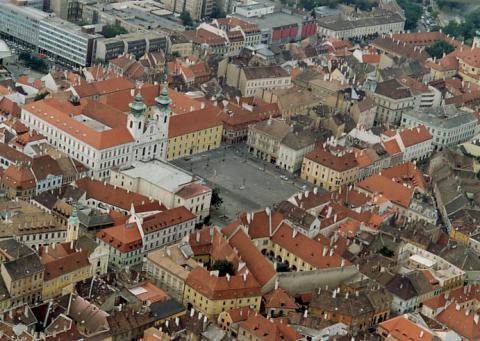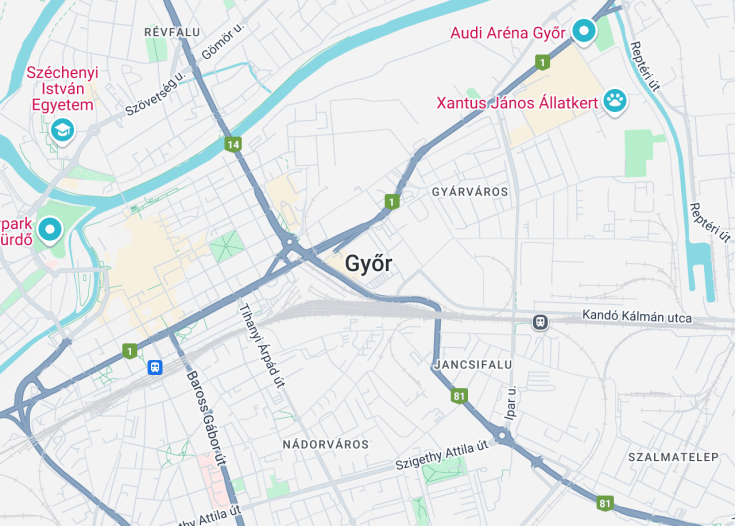Győr, the “City of Waters” located in northwest Hungary, offers a mesmerizing blend of history, culture, and natural beauty. As one of Hungary’s most important cities, it boasts an architecturally rich Baroque town center, numerous museums, and theaters, and is positioned at the meeting point of three rivers – Danube, Rába, and Rábca.
Its well-preserved historic district, vibrant cultural scene, and scenic surroundings make Győr an appealing destination for travelers seeking both relaxation and enrichment.
Explore the city on foot to truly appreciate its intricate Baroque architecture and the lively ambiance of its squares and outdoor cafes.
Visit Győr in the spring or early autumn to enjoy mild weather and fewer crowds, enhancing your experience of the city’s sights and events.
Top things to do & see in Győr
Select the following sights and activities to discover best tickets and tours available in Győr.
Győr: The Heartbeat of Northwest Hungary
| Country | Hungary |
| Time in Győr | GMT+1 |
| Language spoken | Hungarian |
| Population | 129,527 (Source: Hungarian Central Statistical Office, 2022) |
| Currency | Hungarian Forint (HUF, Ft) |
| Airports |
|
Győr, the sixth-largest city in Hungary, is a historical fortress situated at the confluence of the Danube, Rába, and Rábca rivers. Known for its rich heritage, Győr dates back to Roman times when it was known as Arrabona, a significant military outpost. Over the centuries, Győr has been a vital cultural and economic hub in northwest Hungary.
With its beautifully preserved Baroque city center, Győr has evolved into a major tourist destination, attracting visitors with its museums, thermal baths, and vibrant cultural scene. Additionally, the city functions as an automotive and industrial powerhouse in the region, hosting facilities for major international companies.
Strategically located between Budapest, Vienna, and Bratislava, Győr is an industrious melting pot of history, culture, and modernity. Its location has historically made it a linchpin in trade and communication across Central Europe.
Győr’s cathedral, the Basilica of St. Michael, boasts an altar that is a masterpiece of Baroque art, and the city’s cobbled streets and picturesque squares make it a delightful exploration spot. The annual summer festivals and the Audi Factory, one of the most modern production facilities in Europe, add to its allure and economic strength.
Where is Győr?
Győr is located in northwest Hungary, halfway between Budapest in Hungary and Vienna in Austria, making it a central spot in the trans-European road network.
Distances:
| Route | Distance by Car | Time by Car |
|---|---|---|
| Budapest to Győr | 75 miles (120 km) | 1 hour 30 minutes |
| Vienna to Győr | 78 miles (126 km) | 1 hour 20 minutes |
| Bratislava to Győr | 53 miles (85 km) | 1 hour |
What is Győr famous for?
Győr is famed for its Baroque architecture, therapeutic thermal waters, and vibrant cultural life. This city harmoniously blends its historic charm with modern dynamics, making it a unique place to visit or live.
History
Prehistoric Times to the Middle Ages (Before 1000 AD)
The area now known as Győr, nestled at the confluence of three rivers—Danube, Rába, and Rábca—has been inhabited since ancient times. Artifacts from the Neolithic period through to the Roman era indicate a thriving settlement. The Romans established a camp called Arrabona, which was an important outpost of the Empire’s frontier on the Danube. The Mongol invasions of the 13th century left the settlement in ruins, prompting the construction of fortifications that became the core of the medieval town.
The Rise of a Medieval Center (1000 AD – 1500 AD)
Győr played a critical role in the medieval Kingdom of Hungary, achieving the status of a free royal town by the 15th century. Its strategic location enhanced its economic significance, making it a bustling hub in the region. Notably, the town was involved in the defense against Ottoman expansion, transitioning into a military and administrative center.
Ottoman Occupation to Habsburg Monarchy (16th – 18th Century)
The town fell under Ottoman occupation in the 16th century but was reclaimed by the Habsburgs in the late 17th century. Subsequently, Győr flourished under the Habsburg Monarchy, with extensive rebuilding following the wars. This era saw significant baroque reconstruction, giving the city much of its current architectural character.
Modern Developments (19th Century to Present)
Győr expanded rapidly in the 19th century with the arrival of the railway and the development of the industrial sector. The 20th century saw further growth and challenges, including significant damage during World War II and dynamic rebuilding in the post-war era. Today, Győr is a vibrant city known for its rich cultural heritage, thriving automotive industry, and important educational centers.
Visit Győr
What to see and do in Győr
In Győr, visitors can explore a blend of historical and modern attractions. Important sites include the Győr Cathedral with its treasures and relics, and the charming old town with its narrow streets and distinctive baroque buildings. The city is also home to several museums such as the János Xantus Museum. For leisure, the Rába Quelle Thermal Bath offers relaxation.
- Explore the Győr Cathedral and its ecclesiastical treasures.
- Stroll through the old town and admire the baroque architecture.
- Visit the museums, including the János Xantus Museum.
- Relax at the Rába Quelle Thermal Bath.
Notable events in Győr
Győr hosts several recurring events throughout the year. The Győr Summer Cultural Festival offers a wide range of performances and exhibitions in mid to late summer. Another significant event is the Győr Audi Hungaria Motor Festival, which occurs annually, featuring motor races and vehicle exhibitions.
Best time to visit Győr
The best time to visit Győr is during late spring and early fall when the weather is pleasant and suitable for exploring the city. The summer months are ideal for attending local festivals and enjoying the vibrant street life.
Is Győr worth visiting?
Győr is definitely worth visiting due to its rich historical context intertwined with vibrant contemporary culture. The city offers a unique mix of architectural elegance, cultural events, and natural beauty, ideal for travelers seeking both relaxation and a deep dive into Hungary’s storied past.
Győr’s location at the crossroads of major travel routes also makes it an accessible destination for explorers traversing Central Europe.










